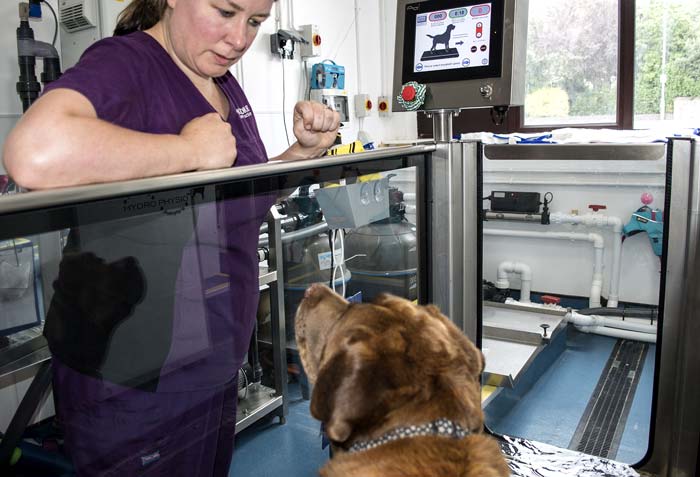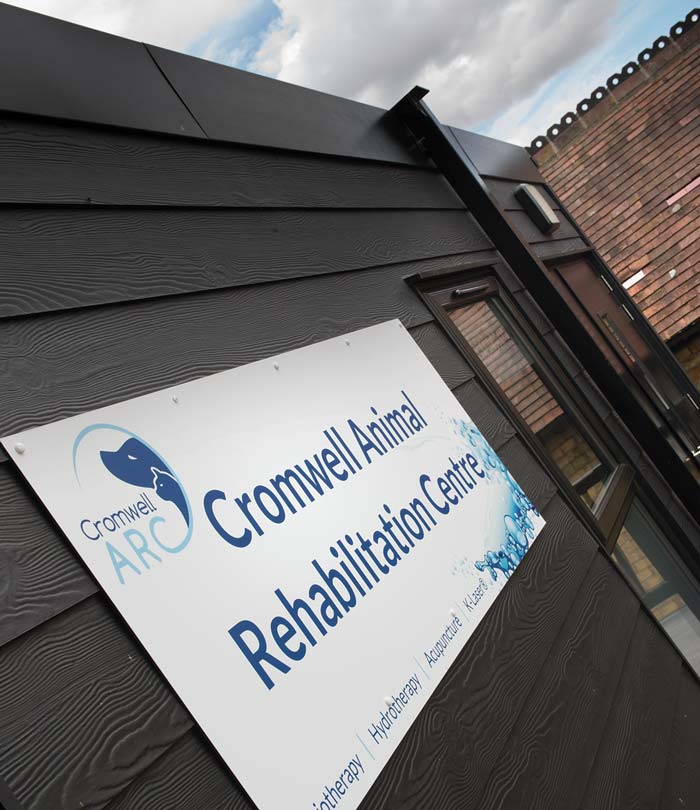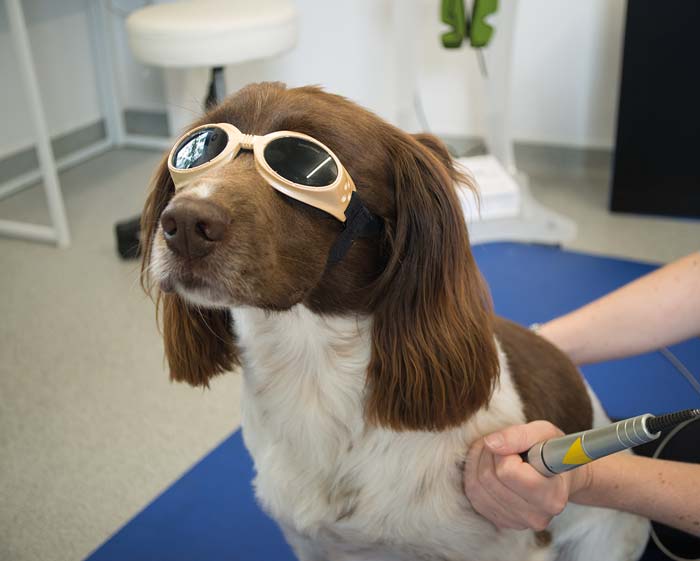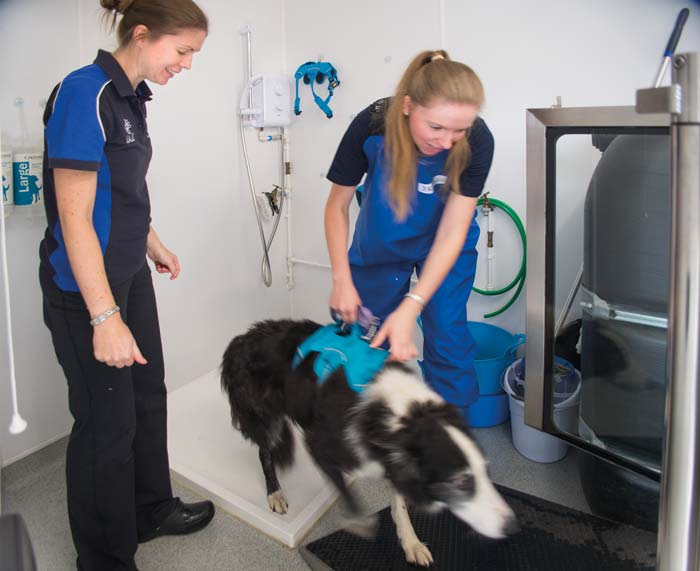1 Oct 2018
James Westgate, VBJ editor, visits two practices using complementary therapies as a viable alternative revenue stream ...

Complementary therapies in veterinary medicine have long been seen as something of a hot potato.
Indeed, very few subjects provoke such strong divisions within the profession – so much so that late last year the RCVS felt compelled to issue a new position statement on the use of complementary and alternative medicines (CAM).
It could be argued this statement did little to clarify the college’s position on the subject, however, it would be fair to say the pet-owning public has made up its own mind.
The benefits of hydrotherapy and physiotherapy have long been established in human medicine, and treatments such as Reiki and acupuncture have also become increasingly popular.
So, with people regularly receiving these treatments themselves, it should be no surprise they are increasingly seeking them out for their pets, too.
One practice that’s making the most of this shift in thinking is Mochdre Vets in north Wales (see VBJ186). Owner and lead vet Sarah Heywood set up her “dream practice” in 2017 with a minimal budget, three members of staff and a focus on complementary medicine.
A little over a year later, the level of demand for these services has helped the practice expand rapidly to the point where it employs a team of 11 with an active client base of roughly 2,000.
Sarah said: “I have always been a believer in complementary therapies and have experience of it as a client as well as a veterinary surgeon. A lot of my CPD has also taken me down the pain management route, and has opened my eyes to a lot of these therapies and how they can help manage pain and improve the lives of our patients.
“So, I always had a vision about what I wanted to offer and the facilities and equipment I needed to make that happen. Pain management has, in my opinion, been massively undertreated and the fact there was nothing else comparable in the whole of north Wales made me want to make the commitment.”
Mochdre boasts the full set of facilities required to offer its complementary veterinary therapies, including a 5m by 3m hydrotherapy pool and a separate hydrotherapy treadmill. These facilities are very striking and doubtless impress many a client, but, as Sarah explained, getting everything in place did not cost as much as you might think.
She said: “I am not saying £150,000 isn’t a lot of money, but that was for the entire practice set up and, for what we have here, it is really not that much when you consider what we have and the benefits it all brings.
“I do think this investment has paid off. We have had some amazing success stories where we have made a real difference in the quality of life for animals and secondary to their humans.”
So, what exactly does Mochdre offer, and what facilities are needed on site to provide them?
“We have the K-Laser, the hydro pool, underwater treadmill, acupuncture, physiotherapy, massage, Reiki, own-brand nutraceuticals and McTimoney Chiropractery, as well as the usual pain reliefs.
“Most of these treatments can be delivered without a lot of expensive kit, though, obviously, the hydrotherapy does require specialist equipment and dedicated space. It’s not just a case of having a pool or treadmill. That, in turn, has to come with a hygienic wash and drying area for your dog, separate waiting areas and additional training and qualified staff.
“We are lucky with the amount of space we have [approximately 4,500 sq ft of a former window and conservatory showroom], which allows us to have a comfortable environment.”
All the facilities were set up to maximise the most of the building, with parking for 18 cars meaning those with dogs in need of treatment are always able to park outside the hydro suite. It also has a separate waiting room for the hydrotherapy and physio areas.
A dedicated complementary treatment room allows Sarah and her team conduct physio, laser therapy, Reiki or acupuncture. The room temperature can be made hot or cold for the massage or Reiki, depending on the requirement – in rooms designed to be bright and spacious.
 While the bulk of Mochdre’s income is generated from conventional veterinary services, Sarah estimates complementary therapies constitute as much as 25% of total practice turnover.
While the bulk of Mochdre’s income is generated from conventional veterinary services, Sarah estimates complementary therapies constitute as much as 25% of total practice turnover.
Decent returns are clearly there for practices prepared to embrace complementary therapies, but there have been significant investments made – both in terms of time and money – to get to this point.
Sarah explained: “Obviously you need highly skilled and properly qualified staff to make this work.
“I am a member of the Association of British Veterinary Acupuncturists, and the British Veterinary Rehabilitation and Sports Medicine Association, and we also have a fully qualified physiotherapist and offer Reiki.
“Equipment-wise, the total cost of a hydrotherapy pool, treadmill and laser therapy ended up being around £75,000 – and that’s aside from preparing the facilities for such equipment. We spent several thousand pounds preparing the pool room itself on things such as drainage, a pool ramp and dehumidifiers.
“I do think it has been a good investment, though. On certain days the rehab side generates more than operations and, if you think of the pool like a member of staff, it’s there generating money on a weekend or late at night – without needing holidays.”
While Sarah admits having the hydro pool did provide her practice the “wow factor” for new clients, it is probably the less showy therapies that generate the highest levels of profit.
She added: “The pool brought us a lot of attention and is a great selling point for all the other the rehabilitation therapies we offer.
“All our treatments are priced equally as we charge for the period of time [usually 30 minutes]. This means people can budget for their treatment knowing exactly what it will cost them. Often they will block-book sessions and part way through their rehabilitation the best course of treatment changes – maybe from hydrotherapy pool to the treadmill.
“So, it is usually a combination of these therapies, but if you look at the cost to provide against the charging cost, acupuncture has to be the most profitable as – staff costs aside – the only cost is a box of needles.”
While Sarah is well aware of the scepticism that surrounds some complementary therapies, she remains convinced by offering them to clients, her practice is merely giving the pet- owning public what it wants.
She added: “There are a lot of recognised studies from professional bodies supporting the use of complementary therapies, plus the NHS advocates and offers these therapies for humans.
“There will always be scepticism from others, unfortunately including some within the veterinary profession, but we are seeing results every single day and the demand continues to grow.”
Sarah explained this is not just among her own client base. “Television shows such as Supervet have highlighted these forms of therapy to a massive audience and – thanks, in part, to the internet – clients are much better informed about what they want for their pet, so I can only see this growing for us.
“We also generate interest by offering free client education events, but, to be honest, most of our success has come through word of mouth.
“We are also getting a lot of referrals and we have more than 20 practices referring their physio cases to us, which speaks for itself really.”
 Complementary therapies were always going to be central to the operation for Sarah and her team at Mochdre Vets. This meant elements such as the hydro pool and physio areas could be planned in from day one, but practices can enter this expanding marketplace in many other ways.
Complementary therapies were always going to be central to the operation for Sarah and her team at Mochdre Vets. This meant elements such as the hydro pool and physio areas could be planned in from day one, but practices can enter this expanding marketplace in many other ways.
Cromwell Vets in Cambridgeshire (the subject of our Practice Profile, starting on page 15) is the perfect example. For a number of years, the six-site first opinion practice had been offering a limited physio service from a consult room at its Huntingdon branch, but a recent spike in demand forced the team to review the options.
With a small capacity and thousands of pounds in potential revenue being referred out the door due to a lack of hydrotherapy facilities, senior animal physiotherapist and RVN Leanne Seymour knew a strong business case existedto be made for scaling up their capacity.
Two years later, the Animal Rehabilitation Centre – or ARC – was born, and the practice has not looked back since.
Rather than extend existing facilities at the Huntingdon branch, however, the practice went for an “out of the box solution” with a pre-fabricated building housing a hydrotherapy and physiotherapy suite.
Leanne explained: “We looked at the options and decided we would locate the ARC at our Sawtry branch as there is a big car park and also room to site the building to house it all.
 “Once that decision was made I started to look at the viability of pre-fabricated buildings, and it was at that point it became clear this would be a sensible and sound move for the business to make.”
“Once that decision was made I started to look at the viability of pre-fabricated buildings, and it was at that point it became clear this would be a sensible and sound move for the business to make.”
Originally, the plan had been to go for an all-in-one solution, with the building and the treadmill coming as one package, but when that didn’t work out another option emerged.
“So we found a suitable treadmill supplier and a company that could lease us a pre-fab, portable-style, modular solution that would fit into the space we had allocated for it [in this case, 9m by 4m],” added Leanne.
The unit chosen came complete with low-energy lighting, timed heater controls, a choice of internal floor and exterior finishes, and gas-filled energy efficient double glazing.
Once treadmill and building suppliers had been found, Leanne and Cromwell practice manager Julie Eastham set about designing the interior layout of the building.
Julie said: “The challenge was we needed something that did the job, could house all the equipment we need and that fitted in with the aesthetic of the practice – that was difficult.
 “It needed to be bespoke inside as it needed to be split into two sections; one for the physio side of things and the other to house the treadmill and the water treatment plant to run it.”
“It needed to be bespoke inside as it needed to be split into two sections; one for the physio side of things and the other to house the treadmill and the water treatment plant to run it.”
It was also a challenge to get the building on site due to a protected walnut tree and the fact it was snowing on the day meaning the crane driver had to be right on his game to get it lowered in the right place.
Julie added: “But we got there and are delighted with the results, it is a solution we would recommend to anyone looking at this type of development for their practice.”
The cost of the entire project was £90,000 – this figure includes £20,000 for a K-Laser system – but it will not be long before that investment has been repaid.
Leanne said: “The ARC has only been open since April, but I would say we have been pretty close to capacity since then and even had a waiting list for its services while it was being installed.
“On our busiest days we have been seeing 24 animals and it’s not a case of robbing Peter to pay Paul; this is an extra revenue stream for the practice, plus it generates revenue in other ways, too.
“For example, we now see more obesity cases, which we can then refer on to our weight clinics, and, obviously, we no longer have to refer out to hydrotherapy pools and treadmills.
“The whole project has been a great success for us and I can see its importance to the practice, both as a revenue stream and a treatment option, growing more significant.”